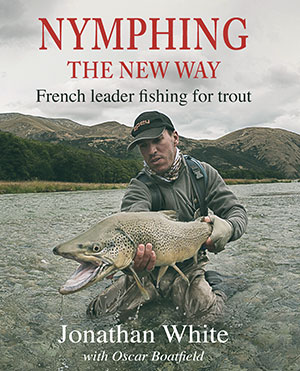The French Leader

Oscar Boatfield using a French leader to nymph with a tight line for winter grayling on the river Itchen in Hampshire.
The leader is the single most important variable in the nymph fisherman’s set-up, and is often the key factor in determining success or failure. The French leader performs in a different way to the conventional leader, thus setting French leader technique apart from other methods. An enormous amount has been written in the quest for a perfect action, and as a result French leaders have evolved to take many different forms. In this chapter, we shall look at some of the main leader variants for both sight and indicator nymphing
and try to identify what are currently the most useful approaches.
 French leaders differ from conventional leaders not only in terms of their greater length, but also their construction, with most top French flyfishermen opting for knotted leaders comprising multiple strands of nylon of varying length and diameter. To many British flyfishermen, perhaps used to buying ready-made leaders ‘off the shelf’, leader constructions of this type can seem at first sight rather complex and technical.
French leaders differ from conventional leaders not only in terms of their greater length, but also their construction, with most top French flyfishermen opting for knotted leaders comprising multiple strands of nylon of varying length and diameter. To many British flyfishermen, perhaps used to buying ready-made leaders ‘off the shelf’, leader constructions of this type can seem at first sight rather complex and technical.
It is certainly true that some time and effort is required to build a couple of knotted leaders that will be appropriate for most purposes. However, this is an investment that will be richly rewarded. These leaders offer major advantages both with regard to delaying the onset of drag and optimising presentation of the fly, allowing for the delicate delivery of even very long tippets. Furthermore, once these leaders are put together they should last a whole season, with only changes to the tippet being necessary.
For ease of comparison for British and American readers, the table (right, above) shows metric and imperial diameters side by side. Breaking strains (BS) are approximate.
Piam’s Original French Leader

Piam, an exceptional sight fisherman from the Jura, is widely credited with the invention of the modern French leader in the mid-1980s. Piam’s revolutionary approach consisted of developing a leader of more than 7 metres in length, at a time when most fishermen were using leaders of 3 to 4 metres. The other distinctive feature of Piam’s leader was that it was constructed from 8 strands of nylon, with each strand progressively lengthening as the diameter of the nylon decreased. The effect of this construction was to impart a ‘slow’ action to the leader, meaning that the leader does not immediately extend over the water. This action permits a delicacy of presentation that is crucial when approaching very shy fish in clear water. Piam’s approach also provides substantial advantages in allowing the angler to fish very fine diameter tippets at significant distance.
Philippe Boisson’s French Leader

As we have seen, Philippe Boisson was an early disciple of Piam who, together with Norbert Morillas, took sight fishing a nymph to new levels in the 1990s. Boisson’s influence on the development of flyfishing in France has been significant, both as a fisherman and as a writer. He was for many years editor of the outstanding French fishing magazine Pêches sportives, and his book De la pêche à la nymphe (2010) is one of the most thoughtful flyfishing books published in any language.
Although Boisson successfully used Piam’s leader construction for many years, he was troubled by its limitations when fishing a tippet of 0.12mm or larger. As the last section of Piam’s leader was itself 0.12mm, it was not possible to add a tippet of 0.12mm or 0.14mm without compromising the performance of the leader. The angler either needs to dispense with the last section of Piam’s formula, thus shortening the whole leader, or he is obliged to modify Piam’s construction. The former is undesirable in most situations, and the latter is cumbersome to achieve on the riverbank.
Boisson’s solution to this problem was to propose an alternative, much simpler, leader construction. Boisson’s leader uses 5 strands of nylon, each of equal length, starting at 0.40mm at the butt and decreasing to 0.18mm for the section preceding the tippet.
Available from neighborhood and on-line booksellers, and in the MidCurrrent Store. Excerpted with permission from “Nymphing: The New Way” (Merlin Unwin Books, 2016). All rights reserved.












